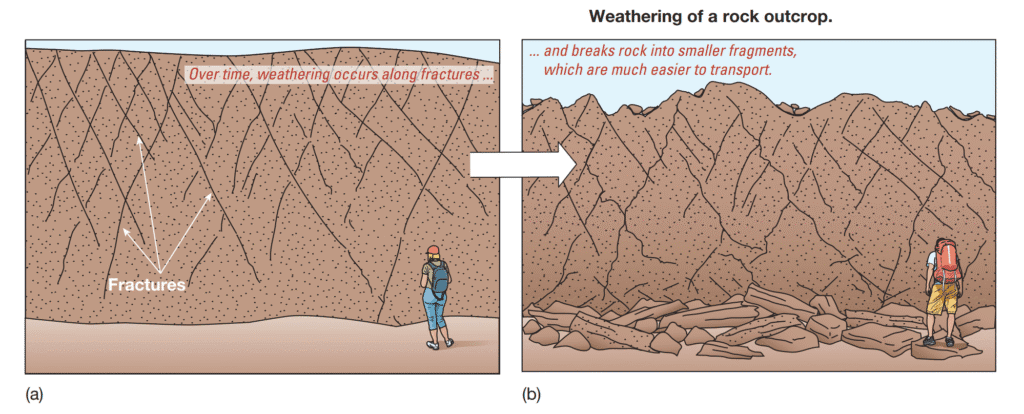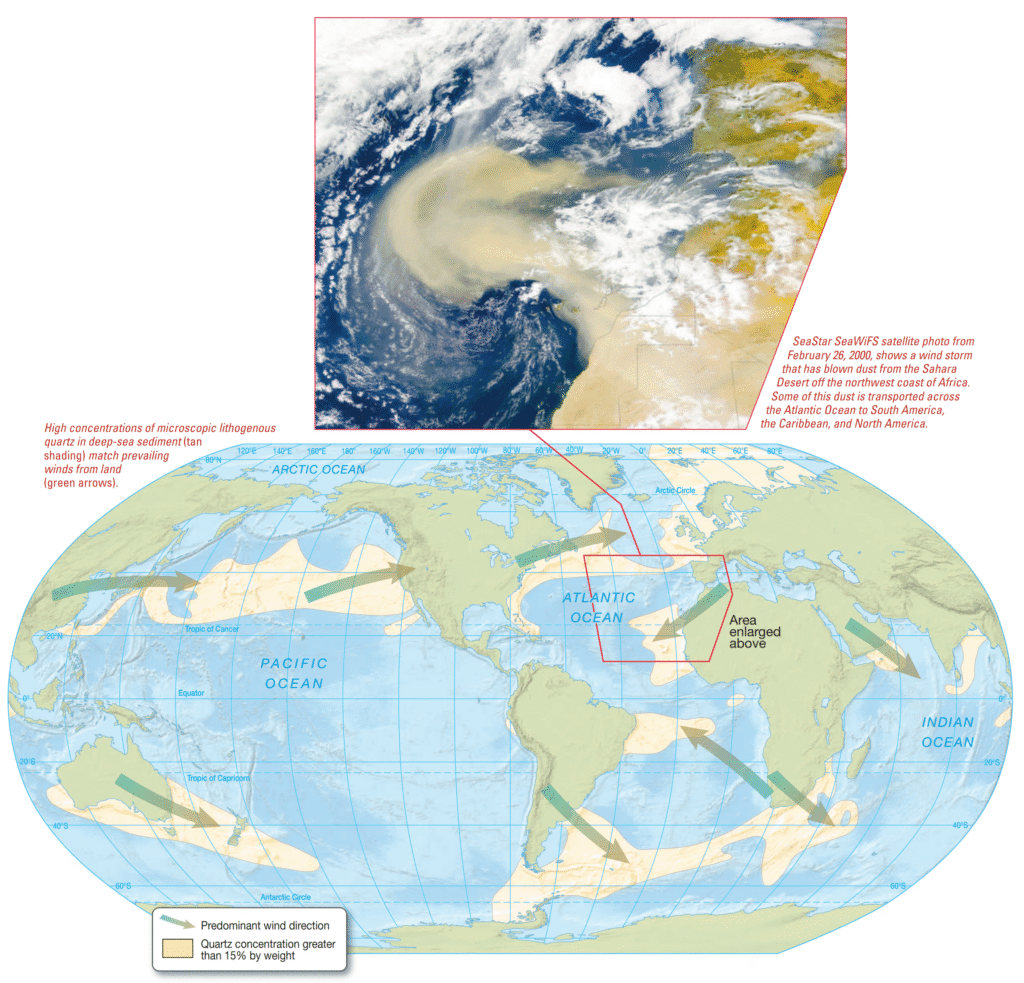Lithogenous sediment (from lithos meaning stone and generare meaning to produce) originates from pre-existing rock formations that are found on continental landmasses or islands. These sediments form through erosional processes, volcanic discharges, or atmospheric dust transport. It is important to note that lithogenous sediment is also known as terrigenous sediment (terra = land, generare = to produce).
Origin of Lithogenous Sediment
Lithogenous material has its genesis in continental or island-based rock structures. Over extended periods, weathering agents—including hydrological forces, thermal variations, and chemical interactions—break down larger rock masses into finer fragments. Once fragmented, these materials become more susceptible to erosion and displacement, forming the fundamental particles that comprise all lithogenous sediments.
Material eroded from terrestrial regions is conveyed to marine environments through various mechanisms such as fluvial systems, aeolian transport, glacial movement, and gravitational descent. Annually, fluvial processes alone contribute approximately 20 billion metric tons (equivalent to 44 trillion pounds) of sediment to the continental boundaries of the oceans, with nearly 40% of this load originating from Asian runoff.
Once in motion, sediment may be deposited in a range of marine and coastal settings. These include bays, lagoons, river deltas, shorelines, or farther out along the continental margin. Additionally, lithogenous particles can be propelled beyond the margin and into abyssal zones via turbidity currents.
The largest accumulations of lithogenous sediments are typically concentrated along continental margins, where they are continually influenced by high-energy coastal currents and submarine turbidity flows. Fine-grained fractions of sediment are distributed into deep-ocean basins by lower-energy currents, where they settle as layered deposits. Furthermore, microscopic particles from atmospheric dust or volcanic ash can traverse vast oceanic distances under the influence of dominant wind systems. These particles ultimately descend into the ocean, either as wind velocity diminishes or when they act as condensation nuclei for precipitation formation, leading to their deposition as thin sedimentary layers on the seafloor.
Composition of Lithogenous Sediment
The composition of lithogenous sediment is directly influenced by the parent rock material from which it originates. All rock structures consist of distinct crystalline forms of naturally occurring compounds, commonly referred to as minerals. Among these, quartz stands out as one of the most abundant, chemically resilient, and mechanically durable minerals within Earth’s crust. Quartz is comprised of silicon and oxygen, forming SiO₂, which is the same chemical structure found in standard glass. This essential mineral constitutes a substantial portion of many igneous, metamorphic, and sedimentary rocks.

Due to its remarkable resistance to physical weathering, quartz can endure abrasion and maintain its integrity over extensive transport distances, allowing it to be deposited far from its original source. As a result, a significant proportion of lithogenous sediments, such as coastal sands, are predominantly composed of quartz particles.
A notable quantity of fine lithogenous material, particularly those that settle in remote oceanic environments, is carried by dominant wind systems. These winds lift minute particles from arid, subtropical desert zones located on continental interiors. The global distribution of such microscopic quartz fragments across surface marine sediments demonstrates a direct correlation with the intensity and direction of prevailing desert winds from regions like Africa, Asia, and Australia.
This connection is substantiated by satellite imagery, which consistently records dust storm activity dispersing these particles across vast oceanic expanses. Importantly, wind transport is not limited solely to sediment particles. Research has established that airborne vectors are capable of conveying an array of suspended materials, including viral agents, environmental pollutants, and even live insect species, from African deserts to distant regions such as North America, traversing the entire Atlantic Ocean.
Sediment Texture
A fundamental characteristic of lithogenous sediment is its texture, with particular emphasis on grain size. According to the Wentworth grain size scale , sedimentary particles are categorized from largest to smallest as boulders, cobbles, pebbles, granules, sand, silt, and clay. The dimension of sediment particles is directly correlated to the energy level necessary for their deposition.
Wentworth Scale of Grain Size for Sediments
| Size Range (millimeters) | Particle Name | Grain Size | Example | Energy of the Depositional Environment |
|---|---|---|---|---|
| Above 256 | Boulder | |||
| 64 to 256 | Cobble | |||
| 4 to 64 | Pebble | |||
| 2 to 4 | Granule | Gravel / Coarse-grained | Coarse material found in streambeds near river sources and along some beaches | High energy |
| 1/16 to 2 | Sand | Beach sand | ||
| 1/256 to 1/16 | Silt | Feels gritty in teeth | ||
| 1/4096 to 1/256 | Clay | Fine-grained | Microscopic; feels sticky | Low energy |
High-energy environments, such as those experiencing intense wave activity, typically result in the accumulation of coarse-grained materials like boulders and cobbles. In contrast, fine-grained sediments are more commonly found in low-energy zones, where current velocities are minimal. Clay-sized particles, many of which possess a flat morphology, tend to exhibit cohesive behavior when deposited. This cohesion necessitates greater energy conditions for their subsequent erosion and transport than would be predicted based solely on particle size.
Overall, lithogenous sediments tend to exhibit a gradation toward finer textures as the distance from the coastline increases. This trend is primarily driven by the dominance of energetic transport processes near shorelines and the presence of relatively quiescent conditions in the deep-ocean basins.
In addition to grain size, the texture of lithogenous sediment is also influenced by its degree of sorting. Sorting refers to the consistency in grain size within a sediment sample and reflects the selective capability of the transporting medium. Well-sorted sediments—typically found in coastal sand dunes—are composed predominantly of particles with uniform dimensions, as wind transport mechanisms are only able to mobilize particles within a specific size range.

Conversely, poorly sorted deposits contain a heterogeneous mixture of particle sizes, indicating that the transporting force was capable of moving a wide spectrum of materials, from clay to boulder-sized fragments. A prominent example of such poorly sorted sediment is found in glacial till, which consists of material that was entrained by glacial ice and later released during melting, leaving behind an unsorted accumulation of diverse grain sizes.
Distribution of Lithogenous Sediment
Marine sedimentary accumulations are broadly classified into two categories: neritic and pelagic. Neritic deposits (neritos = of the coast) occur over continental shelves and in shallow marine environments adjacent to islands. These deposits are generally coarse grained. In contrast, pelagic deposits (pelagios = of the sea) are situated within the deep-ocean basins and typically exhibit a fine-grained texture. Notably, lithogenous sediment is universally distributed across the ocean floor, with at least a minor proportion present in nearly all marine sedimentary contexts.
Neritic Deposits
Lithogenous material constitutes the dominant component of most neritic sedimentary deposits. Originating from continental rock sources situated near the coastline, these deposits are coarse grained and accumulate rapidly across the continental shelf, continental slope, and continental rise. Principal examples of neritic lithogenous sediment include beach deposits, continental shelf deposits, turbidite deposits, and glacial deposits.
Beach Deposits
Beach sediments are composed of locally available materials and are primarily made up of quartz-rich sand, which is delivered to coastal zones by fluvial systems. However, these deposits may vary widely in both grain size and mineralogical composition. The transport mechanism involves wave action, particularly storm-driven waves, which redistribute sediment along the shoreline.
Continental Shelf Deposits
Following the conclusion of the last glacial period approximately 10,000 years ago, melting glaciers induced a global sea-level rise. As a result, numerous rivers now discharge their sediment loads into submerged river mouths, instead of distributing material directly across the continental shelf, as occurred during earlier geological epochs. Consequently, much of the sediment presently found on continental shelves consists of relict deposits (relict = left behind)—remnants from depositional events between 3,000 and 7,000 years ago. These relict sediments currently cover approximately 70% of the world’s continental shelf regions. Additionally, sand ridge formations on some shelves appear to have developed more recently, possibly after the most recent glaciation, and are now located at existing sea depths.
Turbidite Deposits
As previously discussed, turbidity currents represent submarine avalanches that intermittently descend continental slopes, sculpting submarine canyons in the process. These currents transport substantial volumes of neritic sediment, which eventually spread outward as deep-sea fans, contributing to the continental rise and gradually tapering off into the abyssal plains. These resulting turbidite deposits are distinguished by graded bedding, a characteristic form of stratification.
Glacial Deposits
In high-latitude regions of the continental shelf, one may observe poorly sorted sediments containing a broad spectrum of particle sizes, ranging from boulders to clays. These glacial sediments originated during the last ice age, as glaciers advanced over the continental shelf and later receded. Today, glacial deposition continues around Antarctica and Greenland via a process known as ice rafting. In this mechanism, rock fragments encased within glacial ice are carried seaward by icebergs that detach from coastal glaciers. As the icebergs melt, they release lithogenous particles of varied sizes, which subsequently settle onto the ocean floor.
Pelagic Deposits
Although turbidite sediments originating from neritic environments along the continental rise can occasionally extend into the deep-ocean basin, the majority of pelagic deposits consist of fine-grained material that accumulates gradually across the deep-sea floor. Pelagic lithogenous sediments encompass particles derived from volcanic activity, atmospheric dust transport, and fine detritus conveyed by deep-ocean currents.
Abyssal Clay
Abyssal clay is defined as sediment containing at least 70% (by weight) of clay-sized particles originating from continental sources. Despite their considerable distance from land, deep abyssal plains feature extensive deposits of abyssal clay. These particles are transported across vast oceanic expanses by prevailing winds and marine currents, eventually settling on the abyssal seafloor.
Due to the presence of oxidized iron compounds, abyssal clays typically display reddish-brown or buff-colored hues and are often referred to as red clays. Their dominance in abyssal plain regions is not a consequence of exceptionally high clay input, but rather the scarcity of other sedimentary components that might otherwise dilute the deposit. This lack of competing sediment types allows abyssal clay to accumulate as a primary lithogenous material in these deep-sea environments.
Reference: All images and content are taken from Essentials of Oceanography by Alan P. Trujillo and Harold V. Thurman, 12th Edition.
